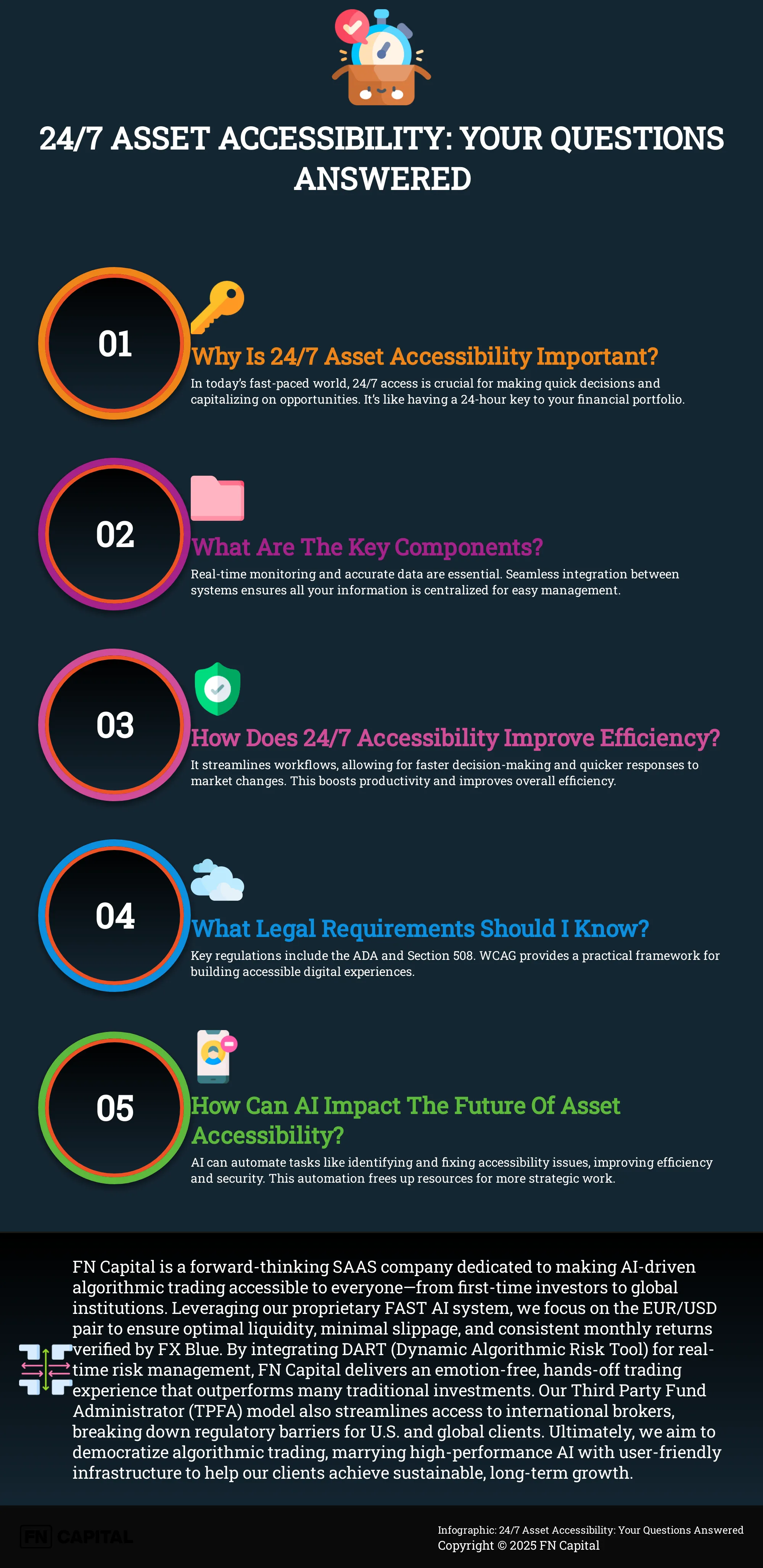In today’s interconnected world, instant access to information and resources is no longer a luxury—it’s an expectation. Whether you’re managing investments, tracking inventory, or ensuring your website reaches the widest possible audience, 24/7 asset accessibility has become mission-critical. This constant availability empowers you to react swiftly to market changes, optimize resource allocation, and create a seamless user experience for everyone. This article explores the key components of 24/7 asset accessibility, its benefits, and how to implement it effectively in your organization. We’ll also examine the legal landscape of digital accessibility and discuss the future of this rapidly evolving field.
Key Takeaways
- 24/7 asset accessibility empowers you to take control of your financial future: Respond to market changes instantly, manage risk effectively, and maintain a clear view of your portfolio at all times.
- Real-time monitoring and data accuracy are essential for true 24/7 access: Seamless integration with platforms like FX Blue ensures transparency and allows you to make informed decisions based on up-to-the-minute information.
- Implementing 24/7 accessibility is an ongoing journey, not a destination: Regularly assess your systems, refine your strategy, and train your team to ensure continuous improvement and compliance.
What is 24/7 Asset Accessibility?
24/7 asset accessibility means you can access and manage your assets anytime, day or night. Think of it as having a 24-hour key to your financial portfolio. This constant access is crucial for making quick decisions, capitalizing on opportunities, and addressing any issues that may arise, no matter the time or time zone. In the fast-moving world of finance, this constant availability can be the difference between maximizing profits and missing out.

Definition and Importance
At its core, 24/7 asset accessibility ensures that your investments and financial tools are always within reach. This empowers you to respond to market fluctuations, manage risk effectively, and maintain a clear overview of your financial position. For example, imagine a sudden market shift occurs overnight. With 24/7 access, you can adjust your portfolio immediately, mitigating potential losses or even taking advantage of the new market conditions. Without it, you’d be stuck waiting until the next business day, potentially losing valuable time and money. This constant access also contributes to peace of mind, knowing you’re always in control of your financial destiny. This level of control is particularly valuable in the volatile world of forex, where split-second decisions can have a significant impact.
Key Components
Several key elements make true 24/7 asset accessibility possible. Real-time monitoring is essential, providing up-to-the-minute data on your assets and their performance. Accurate data is equally important; outdated or incorrect information can lead to poor decisions. Finally, seamless integration between various asset management systems is key. This integration creates a centralized hub where you can view and manage all your assets, regardless of where they’re held. Think of platforms like FX Blue, which offer real-time performance tracking and trade verification, contributing to the transparency and accessibility of your trading activities. Robust asset management strategies often incorporate these components to ensure efficient tracking and management, allowing for continuous visibility and control. This comprehensive approach is crucial for achieving true 24/7 accessibility and maximizing your potential in the financial markets.
Why 24/7 Asset Accessibility Matters
Having your digital assets available 24/7 is more than just a convenience—it’s a fundamental shift in how we interact with information and conduct business. It impacts everything from market reach and user experience to legal compliance and operational efficiency. Let’s explore why prioritizing 24/7 asset accessibility is crucial for success.
Expand Market Reach
Imagine a potential customer trying to access your website only to find they can’t because of incompatibility with their assistive technology. You’ve just lost a sale and potentially a loyal customer. 24/7 accessibility, combined with a commitment to web accessibility, opens your business to a wider audience, including people with disabilities. This not only increases your potential customer base but also demonstrates your commitment to inclusivity and expands your market reach.
Improve User Experience
A seamless user experience is paramount in today’s digital landscape. When your assets are accessible around the clock, users can engage with your content and services on their own terms. This flexibility fosters a positive user experience, leading to increased engagement, higher conversion rates, and improved customer satisfaction. Tracking key performance indicators related to accessibility can help you identify areas for improvement and ensure a consistently positive experience for all users.
Reduce Legal Risks
In many countries, digital accessibility is not just good practice—it’s the law. Failing to meet accessibility standards can result in hefty fines and legal battles. By prioritizing 24/7 accessibility and adhering to guidelines like the Americans with Disabilities Act (ADA), you can mitigate legal risks and protect your business from potential lawsuits.
Increase Operational Efficiency
When your team can access critical information anytime, anywhere, it streamlines workflows and boosts productivity. 24/7 asset accessibility eliminates delays caused by limited access, allowing for faster decision-making and improved operational efficiency. This can translate to significant cost savings and a more agile response to market demands. Learn more about achieving operational excellence through effective asset management.
Essential Services for 24/7 Asset Accessibility
Ensuring your digital assets are accessible around the clock requires a multi-faceted approach. Here’s a breakdown of essential services that contribute to true 24/7 asset accessibility:
Remediate Documents
Start by addressing your documents. A truly accessible online presence means all content is available to everyone, regardless of ability. This includes PDFs, Word documents, and presentations. Remediating these documents ensures they conform to accessibility standards like PDF/UA, WCAG 2.0, HHS, Section 508, and the ADA. Think of it as translating your documents into a universal language everyone can understand. Services like 247 Accessible Documents can help achieve 100% document accessibility.
Audit Website Accessibility
Regular website accessibility audits are crucial. Even if you’re aware of accessibility best practices, it’s easy to overlook issues. A comprehensive accessibility audit identifies and categorizes accessibility barriers, providing a roadmap for improvements. This ensures your website remains usable and inclusive for all visitors.
Provide Ongoing Support and Maintenance
Accessibility isn’t a one-time fix. It requires ongoing support and maintenance. Just like any other aspect of your online presence, accessibility needs to be monitored and updated regularly. This includes ensuring your website remains compliant with evolving standards and addressing any new accessibility issues that may arise. A solid Cybersecurity Asset Management strategy can help you track, secure, and manage IT assets, ensuring compliance and mitigating risks.
Track and Monitor Assets in Real Time
Knowing where your assets are and how they’re performing is key to maintaining 24/7 accessibility. Real-time asset tracking provides 24/7 visibility, allowing you to immediately see if assets are being fully utilized and identify any potential access disruptions. This proactive approach minimizes downtime and ensures consistent accessibility for all users.
The Legal Side of Digital Accessibility
Ensuring your digital assets are accessible isn’t just good practice—it’s often a legal requirement. Several key laws and guidelines shape the landscape of digital accessibility, and understanding them is crucial for minimizing legal risks and creating an inclusive online presence.
ADA Compliance
The Americans with Disabilities Act (ADA) mandates equal access to services and information for all individuals, regardless of disability. This includes digital content, which must be accessible to people with a range of impairments. While the ADA doesn’t explicitly define web accessibility standards, it’s widely understood that websites and digital platforms must adhere to accessibility guidelines to comply. Failing to provide accessible digital experiences can lead to legal challenges and damage your brand’s reputation. For a deeper understanding of these principles, explore Accessiblu’s insights on web accessibility.
Section 508 Requirements
Section 508 of the Rehabilitation Act builds upon the ADA by specifically addressing electronic and information technology used by federal agencies. It requires these agencies to make their digital content accessible, ensuring usability for individuals with various disabilities. This includes websites, software, and other digital tools. Section 508’s key performance indicators offer a helpful framework for government agencies to measure and improve their accessibility efforts.
WCAG Guidelines
The Web Content Accessibility Guidelines (WCAG) offer a practical framework for building accessible digital experiences. These guidelines, developed by the World Wide Web Consortium (W3C), provide specific criteria for making web content perceivable, operable, understandable, and robust. Following WCAG is essential for organizations aiming to comply with the ADA and Section 508. Resources like those available on Inclusive Web offer valuable insights into applying WCAG and measuring its impact. By adhering to WCAG, you can create digital experiences that are inclusive and user-friendly for everyone.
How to Implement 24/7 Asset Accessibility
Implementing 24/7 asset accessibility is a multi-faceted process. It requires careful planning, dedicated resources, and a commitment to ongoing improvement. Here’s a breakdown of the key steps:
Assess Current Accessibility
Before improving accessibility, you need a clear picture of your current state. This involves auditing your existing assets—including websites, documents, and other digital materials—to identify any accessibility barriers. Consider who needs access to these assets and their business requirements. A comprehensive asset information strategy should outline these requirements and address necessary data quality aspects like completeness, accuracy, timeliness, and accessibility. This initial assessment will serve as your baseline and inform your accessibility strategy.
Develop an Accessibility Strategy
Once you understand your current accessibility landscape, develop a tailored strategy to address the identified gaps. This strategy should include specific goals, timelines, and assigned responsibilities. Prioritize the most critical accessibility issues and establish a clear roadmap for remediation. Defining the right accessibility metrics is crucial, providing insights to target your backlog of accessibility issues while improving compliance and the accessibility skills of your development teams.
Train Your Team
Accessibility is a team effort. Equipping your team with the knowledge and skills they need is essential for successful implementation. Training should cover accessibility best practices, relevant guidelines (like WCAG), and the use of assistive technologies. By tracking the right metrics and KPIs, your organization can gain valuable insights into the effectiveness of your accessibility initiatives and identify areas for improvement. This data-driven approach ensures your training program remains relevant and impactful.
Integrate with Existing Systems
Seamless integration with your existing systems is key for long-term accessibility success. This might involve incorporating accessibility checks into your content creation workflow, integrating with your content management system (CMS), or leveraging maintenance management software. Automating tasks like scheduling maintenance, tracking asset performance, and maintaining accurate records can significantly improve the availability and reliability of your assets, ensuring they remain accessible to everyone. A well-integrated system streamlines the accessibility process and makes it a sustainable part of your operations.
Common Challenges and Solutions
Making your assets accessible 24/7 takes ongoing effort. It’s not a set-it-and-forget-it project. Let’s explore some common roadblocks and how to address them.
Allocate Resources Effectively
One of the first hurdles is often resource allocation. Effective asset information management is essential, but many organizations face challenges securing budget and personnel. Like any important business initiative, accessibility requires dedicated resources. Start by identifying key stakeholders and outlining clear roles and responsibilities. This ensures everyone understands their contribution and helps you manage expectations. Prioritize tasks based on impact and feasibility, focusing on quick wins to demonstrate value and build momentum. This phased approach can help justify further investment down the line.
Maintain Ongoing Compliance
Accessibility isn’t a one-time fix. Websites and digital content constantly evolve, so ongoing compliance is crucial. Automated accessibility solutions are helpful, but they don’t catch everything. Regular manual audits and user testing are essential to identify and address more nuanced accessibility issues. Think of it like maintaining a car—regular checkups and adjustments are needed to keep things running smoothly. Set up a schedule for ongoing monitoring and updates to stay ahead of potential compliance issues. As we’ve seen, even with dedicated efforts, businesses can struggle with website accessibility, so vigilance is key. Simple solutions aren’t enough; a comprehensive approach is necessary for long-term success.
Balance Accessibility and Design
Sometimes, there’s a perceived tension between accessibility and design. People worry that making a website accessible will compromise its aesthetics. However, good design and accessibility go hand in hand. In fact, many accessibility best practices, like clear navigation and consistent layouts, actually improve the user experience for everyone. Focus on inclusive design principles from the start to create a website that is both beautiful and usable for all. Remember, accessibility is about removing barriers, not limiting creativity. For inspiration and guidance, explore the W3C’s resources on inclusive design.
Ensure Data Accuracy and Integration
Finally, data accuracy and integration can be a significant challenge. If your asset information is incomplete, inaccurate, or difficult to access, it hinders your accessibility efforts. Develop a robust asset information strategy that outlines clear data quality standards. This includes ensuring data completeness, accuracy, timeliness, and accessibility. You can find helpful guidance on creating an effective strategy in this article on asset management challenges. Integrate your accessibility tools and processes with existing systems to streamline workflows and avoid data silos. This ensures everyone has access to the information they need, when they need it, to support your accessibility goals.
Choosing a 24/7 Asset Accessibility Provider
Finding the right partner for 24/7 asset accessibility is crucial for creating an inclusive online experience. Here’s what to consider when evaluating providers:
Key Features
Look for features that blend automated and manual testing. Automated tools efficiently scan for common accessibility issues, while manual audits provide a deeper look into user experience. A provider like Level Access offers this combined approach alongside strategic consulting and ongoing monitoring against standards like WCAG 2.1 AA and the Americans with Disabilities Act (ADA). This multifaceted strategy helps maintain high accessibility standards and minimizes non-compliance risks. Features like ongoing monitoring and reporting are also essential for tracking progress and identifying emerging issues.
Pricing and ROI
Accessibility is an investment. Understanding the pricing structure and potential return on investment (ROI) is key. Many providers, such as EqualWeb, highlight how their tools prevent costly lawsuits and boost brand reputation by proactively addressing accessibility issues. This forward-thinking approach can lead to long-term savings and increased user engagement. Consider the long-term costs of not prioritizing accessibility, including potential legal fees and damage to your brand image.
Service Level Agreements
Clear Service Level Agreements (SLAs) outline the expectations between you and the provider. Level Access, for instance, specifies response times for software issues, ensuring timely support for critical accessibility concerns. A well-defined SLA clarifies the support you can expect and ensures accountability from your chosen provider. Look for SLAs that address response times, issue resolution, and ongoing maintenance.
Top Providers
Here are a few providers to explore:
FN Capital
FN Capital invests in innovative accessibility solutions, focusing on enhancing digital experiences for all users. We understand that accessibility is not just a compliance requirement, but a core value that strengthens businesses and fosters inclusivity.
AccessiBe
AccessiBe offers an AI-powered solution that automatically adjusts websites to meet accessibility standards, a popular choice for businesses seeking quick compliance.
UserWay
UserWay provides a comprehensive accessibility widget that allows users to customize their web experience, ensuring compliance with various regulations.
AudioEye
AudioEye focuses on continuous monitoring and remediation of accessibility issues, a robust solution for organizations committed to ongoing compliance.
EqualWeb
EqualWeb offers a suite of tools for auditing and maintaining web accessibility, emphasizing compliance to avoid legal problems.
Level Access
Level Access is known for its extensive services, including accessibility audits and strategic consulting, helping organizations integrate accessibility into their development processes.
Siteimprove
Siteimprove provides a comprehensive platform for managing digital accessibility, including training and support to ensure compliance.
Deque Systems
Deque Systems is known for its robust accessibility testing tools and training resources, helping organizations build accessible digital experiences from scratch.
Measuring the Impact
Knowing whether your accessibility efforts are paying off is crucial. You need to measure your impact to demonstrate compliance, improve user experience, and justify the investment. Tracking the right metrics and Key Performance Indicators (KPIs) offers insights into what’s working and where you need to improve. Here’s how to measure the impact of 24/7 asset accessibility:
User Engagement
Increased user engagement is a strong indicator of improved accessibility. Look for increases in:
- Page views: Are users accessing more content than before?
- Time on page: Are users spending more time engaging with your assets? This can signal that your content is easy to consume and interact with.
- Bounce rate: A lower bounce rate suggests users find your content accessible and engaging.
- Social shares: Accessible content is more likely to be shared, expanding your reach and brand awareness.
Conversion Rates
Accessibility improvements should lead to higher conversion rates. Track these metrics:
- Sales: Are sales increasing after implementing accessibility changes? This is a direct measure of the impact on your bottom line.
- Leads: Are you generating more leads through accessible forms and contact methods?
- Sign-ups: Track sign-ups for newsletters, downloads, and other gated content. This shows increased user interest and engagement.
- Completed transactions: A higher completion rate for online purchases or applications indicates improved accessibility.
Customer Satisfaction
Happy customers are more likely to return and recommend your business. Gauge customer satisfaction through:
- Surveys: Ask users directly about their experience with your accessible assets. This provides valuable qualitative feedback.
- Feedback forms: Provide easy-to-use feedback mechanisms on your website and other platforms. Make it simple for users to share their thoughts.
- Social media monitoring: Track mentions and comments related to accessibility on social media. This gives you a sense of public perception.
- Customer support interactions: Analyze customer support inquiries related to accessibility issues. Fewer inquiries suggest improved accessibility.
Cost Savings
While accessibility requires an initial investment, it can lead to long-term cost savings:
- Reduced legal risk: Proactive accessibility measures minimize the risk of costly lawsuits and legal battles.
- Lower development costs: Addressing accessibility early in the development process is more cost-effective than fixing issues later. Retrofitting can be time-consuming and expensive.
- Decreased customer support costs: Improved accessibility can reduce the volume of accessibility-related support inquiries, freeing up your team’s time.
Compliance and Risk Mitigation
Measuring compliance helps you stay ahead of legal requirements and mitigate potential risks. Track these areas:
- WCAG conformance: Regularly audit your assets for compliance with the Web Content Accessibility Guidelines (WCAG). These guidelines provide a framework for making web content more accessible.
- ADA compliance: Ensure your digital assets meet the requirements of the Americans with Disabilities Act (ADA). The ADA prohibits discrimination based on disability.
- Section 508 compliance: If you work with federal agencies, ensure compliance with Section 508 of the Rehabilitation Act. This law requires federal agencies to make their electronic and information technology accessible to people with disabilities.
- Accessibility audits: Conduct regular audits to identify and address accessibility gaps. These audits can be performed internally or by external accessibility specialists.
By consistently monitoring these metrics, you can demonstrate the value of your accessibility initiatives, improve user experience, and ensure long-term compliance.
The Future of 24/7 Asset Accessibility
As technology evolves, so too does the landscape of accessibility. Several key advancements are shaping the future of 24/7 asset accessibility, promising even greater inclusivity and efficiency.
AI and Machine Learning
Artificial intelligence and machine learning are poised to revolutionize how we approach accessibility. AI-powered tools can automatically identify and fix accessibility issues in real time, reducing the manual effort required for compliance. Imagine AI algorithms scanning website code for WCAG violations or automatically generating alt text for images. This streamlines the remediation process and allows for continuous monitoring and improvement. As cyber threats grow more sophisticated, AI can play a crucial role in identifying vulnerabilities and protecting digital assets, as highlighted by StratusIP. This proactive security approach ensures assets remain accessible and secure, even against evolving threats.
Mobile-First Accessibility
With the increasing prevalence of mobile devices, ensuring accessibility on smartphones and tablets is more critical than ever. A mobile-first approach to accessibility means designing and developing digital experiences with mobile users in mind from the outset. This includes considerations like responsive design, touch-friendly navigation, and compatibility with assistive technologies like screen readers on mobile platforms. Prioritizing mobile accessibility ensures users can access information and services regardless of their device, creating a more inclusive digital environment. As Accessiblu points out, addressing common misconceptions about web accessibility is key to building truly inclusive digital experiences.
IoT and Asset Tracking
The Internet of Things (IoT) is transforming how we manage and interact with physical assets. IoT-enabled devices allow for real-time tracking and monitoring, providing valuable insights into asset performance, location, and usage. This data helps improve efficiency, reduce costs, and enhance security. For example, imagine tracking medical equipment in a hospital to ensure it’s always available or monitoring inventory levels in a warehouse to prevent stockouts. Avenue emphasizes how important effective asset information management is for operational excellence. Early identification of potential issues, as discussed by HashMicro, is crucial for proactive asset management. Integrating IoT technology with accessibility solutions helps organizations create a seamless and inclusive experience for managing and accessing both physical and digital assets.
Related Articles
- AI Works 24/7: How It Maximizes Investment Returns – FN Capital
- Financial Autonomy Solutions: Transforming the World of Finance – FN Capital
- Asset Management: 7 Powerful Ways AI is Shaping the Future of Global Asset Management – FN Capital
- AI-Driven Trading vs. Traditional Management: Which Is Right for You? – FN Capital
- Secure Wealth Growth: Practical Steps for Building Wealth – FN Capital
Frequently Asked Questions
Why is 24/7 asset accessibility important in forex trading?
Forex markets operate around the clock, so 24/7 access lets you react to market changes, manage your investments, and make informed decisions anytime, maximizing potential profits and minimizing potential losses. It also offers peace of mind, knowing you’re always in control.
What are the key components of 24/7 asset accessibility?
Real-time monitoring with accurate data is crucial. You need up-to-the-minute information to make informed decisions. Seamless integration between different systems ensures all your information is in one place, simplifying management and providing a comprehensive overview. Platforms like FX Blue, with real-time performance tracking, exemplify this.
How does 24/7 accessibility improve operational efficiency?
When your team can access necessary information anytime, it streamlines workflows and boosts productivity. This allows for quicker decision-making, faster responses to market changes, and overall improved efficiency. It’s like having all your tools readily available, eliminating delays and maximizing productivity.
What legal requirements should I be aware of regarding digital accessibility?
Key regulations include the Americans with Disabilities Act (ADA), which mandates equal access to information regardless of disability, and Section 508 of the Rehabilitation Act, which focuses on accessibility in federal agencies. WCAG (Web Content Accessibility Guidelines) provides a practical framework for building accessible digital experiences.
How can AI and machine learning impact the future of asset accessibility?
AI can automate tasks like identifying and fixing accessibility issues, generating alt text for images, and even scanning for WCAG violations. This reduces manual effort, allows for continuous improvement, and enhances security by proactively identifying vulnerabilities. This automation frees up human resources to focus on more strategic tasks.





